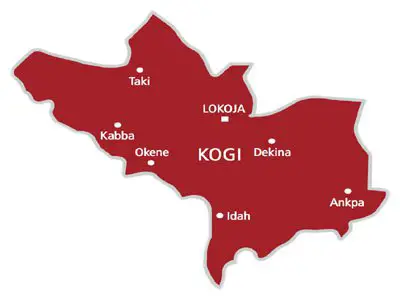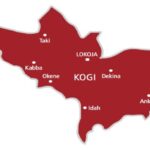The erosion menace in Lokoja, the capital of Kogi State, is as lethal and as old as the town itself, Daily Trust learnt.
The topography of the old town is said to predispose it to erosion, lying on the western bank of the rivers Niger/Benue confluence.
Some residents have also identified the impact of climate change as manifesting in the devastating floods of 2012 and 2022.
They said many Lokoja suburbs were eroded during the floods and they have remained in that state ever since.
- Police disperse anti-subsidy protest in Kano, workers adamant in Oyo
- FCT-IRS rakes in N98.5bn in 7 months
Parts of Lokoja metropolis are cut off by gullies and the like, affecting residents or settlements; including cutting roads and making them impassable.
According to the residents, settlements around the rivers Niger/Benue banks and those at the slope of Mount Patti in Lokoja are always at the receiving end of water erosion caused by incessant flooding and water that collects from higher ground.
“The rivers Niger and Benue have a natural and constant impact on the environment of Lokoja, right from time immemorial. But, we noticed with surprise that in 2012, the water flow caused erosion at a higher magnitude, degrading the environment of Adankolo, Gadumo, Ganaja and other areas in Lokoja,” Dogwo Alaghani, a resident of Adankolo said.
Also, Alaghani said the water that flows from Mount Patti to River Niger whenever it rained caused erosion in the Kabawa area of Lokoja.
“The 2012 flood impact in Lokoja metropolis caused ditches which have now developed into gullies, threatening the lives and property of residents, and in some areas, destroying public infrastructure,” he said.
For instance, on both sides of a deep gully lay Anguwan Rimi and Kabawa, two ancient and densely populated suburbs of Lokoja. The popular area, known in the colonial era as Bynnhool Street has been battling with environmental degradation for ages, with no end in sight.
Incidentally, the residents on both sides of the deep gully have turned the place into a dump site and open defecation
The areas are thus, always oozing with putrid odour, making them susceptible to epidemics.
According to a resident, Danlami Bala, whenever there is torrential downpour, the waste is washed into some homes, creating fears of an outbreak of water-borne diseases.
The youth leader of the community, Maikan Kantan, lamented that the gully erosion has come to stay and the residents had taken it as their own fate, saying it has defied all efforts to control.
He stressed that the water channels in the areas were collapsing with the intensity of floods, affecting many houses, streets and roads, which put the lives of the residents in danger.
Kantan said past administrations’ attempts, including individual efforts, could not stop the water flow channels from carving in.
“The water, which cascades from Mount Patti, has one of its flow lines to River Niger via this area; the gully erosion keeps expanding every wet season, inflicting untold hardships on the residents.
“Captain Idris Wada, the ex-governor of the state came to Madabo-Kabawa here to assess the damage the erosion was causing the street, after distress calls and he promised to do something shortly but did not until his tenure expired, even despite sending emissaries to remind him constantly to fulfil his promise.
“The Lokoja Local Government Chairman, Dan Asabe Mohammed, who responded and even flagged off the project with fanfare, abandoned it midway for no reason known to us,” said Kantan.
He added that the Lokoja Forum group that was moved by the hardships of the residents brought in professionals and the bill of quantity survey was drawn up to that effect, but nothing has been done yet.
He said, “Unfortunately, the politicians in their attempt to get support from the residents use the issue of the gully erosion menace in our domain to campaign every time there is an election.”
An elder and community leader, Alhaji Bosi Ataohi, said the topography of the settlements has made the areas prone to erosion.
He said currently, the community is battling with that of Anguwan Rimi and Anguwan Kura where the residents are having a raw deal with nature, particularly during the wet season.
It was also gathered that the erosion broke open some graves in Anguwan Kura cemetery.
“In 1993, 2012 and 2022, flooding destroyed part of the Anguwan-Kura cemetery and exhumed many dead bodies, creating a pathetic scene in the environment.
“The community rose up to the occasion; people donated money, food and various items, including labour and the cemetery was reinforced or fortified with the necessary materials to check the erosion problem,” Ataohi said.
It was gathered that a portion of the road from Ganaja flyover to Phase I, opposite the police station before Phase II is gradually crumbling.
Another such death trap was spotted, about a kilometer after Charlie Maigumeri barracks in Lokoja, on the way to Kabba junction linking up the Abuja-Lokoja-Okene highway.
The road portion that collapsed without any warning is seen by many as a death trap for unsuspecting motorists and commuters or even pedestrians if nothing is done quickly to reclaim such places prone to flooding and erosion.
“The erosion is claiming this busy road which serves motorists plying the Lokoja-Okene axis of the town. But the authorities concerned do not see it as an issue now, until someone is killed here,” Olayiwola Bolanle, a resident of the area said.
A shop owner reported that a few months ago, an unsuspecting Keke Napep rider fell into a ditch near Phase II, with the occupants of the tricycle surviving death by the whiskers; coming out of it with bruises all over their body.
A civil servant living in that part of Lokoja, Amodu Agada said, “The erosion on Ganaja road has made life more difficult for us in this era of fuel subsidy. For a permanent solution, the place needs a flyover. No reinforcement can save the road from the ravaging erosion.”
However, some residents in Lokoja commended the efforts of the state government and individuals for fixing some of the spots threatened by erosion in Lokoja, but said efforts need to be intensified to address the menace in many areas of the town.
Meanwhile, the state government said as part of the effort to address the erosion menace in Lokoja metropolis, the Ministry of Environment has been empowered to carry out a “clean-up exercise” to allow the free flow of water in drainage to the River Niger.
The Commissioner of Environment, Hon. Victor Omofaye, said the exercise is aimed at clearing the ground to check erosion and its attendant consequences in the event of flooding.

 Join Daily Trust WhatsApp Community For Quick Access To News and Happenings Around You.
Join Daily Trust WhatsApp Community For Quick Access To News and Happenings Around You.


